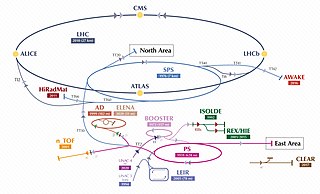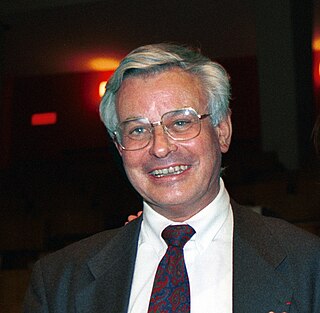
The European Organization for Nuclear Research, known as CERN, is an intergovernmental organization that operates the largest particle physics laboratory in the world. Established in 1954, it is based in a northwestern suburb of Geneva, on the France–Switzerland border. It comprises 23 member states, and Israel is currently the only non-European country holding full membership. CERN is an official United Nations General Assembly observer.

Carlo Rubbia is an Italian particle physicist and inventor who shared the Nobel Prize in Physics in 1984 with Simon van der Meer for work leading to the discovery of the W and Z particles at CERN.

The antiproton,
p
, is the antiparticle of the proton. Antiprotons are stable, but they are typically short-lived, since any collision with a proton will cause both particles to be annihilated in a burst of energy.

Georges Charpak was a Polish-born French physicist, who was awarded the Nobel Prize in Physics in 1992.
Hadronization is the process of the formation of hadrons out of quarks and gluons. There are two main branches of hadronization: quark-gluon plasma (QGP) transformation and colour string decay into hadrons. The transformation of quark-gluon plasma into hadrons is studied in lattice QCD numerical simulations, which are explored in relativistic heavy-ion experiments. Quark-gluon plasma hadronization occurred shortly after the Big Bang when the quark–gluon plasma cooled down to the Hagedorn temperature when free quarks and gluons cannot exist. In string breaking new hadrons are forming out of quarks, antiquarks and sometimes gluons, spontaneously created from the vacuum.

The Super Proton Synchrotron (SPS) is a particle accelerator of the synchrotron type at CERN. It is housed in a circular tunnel, 6.9 kilometres (4.3 mi) in circumference, straddling the border of France and Switzerland near Geneva, Switzerland.
The French National Institute of Nuclear and Particle Physics is the coordinating body for nuclear and particle physics in France. It was established in 1971 as a division of the French National Centre for Scientific Research (CNRS). Its purpose is "to promote and unite research activities in the various fields of physics".
The Hagedorn temperature,TH, is the temperature in theoretical physics where hadronic matter is no longer stable, and must either "evaporate" or convert into quark matter; as such, it can be thought of as the "boiling point" of hadronic matter. It was discovered by Rolf Hagedorn. The Hagedorn temperature exists because the amount of energy available is high enough that matter particle (quark–antiquark) pairs can be spontaneously pulled from vacuum. Thus, naively considered, a system at Hagedorn temperature can accommodate as much energy as one can put in, because the formed quarks provide new degrees of freedom, and thus the Hagedorn temperature would be an impassable absolute hot. However, if this phase is viewed as quarks instead, it becomes apparent that the matter has transformed into quark matter, which can be further heated.

Rolf Hagedorn was a German theoretical physicist who worked at CERN. He is known for the idea that hadronic matter has a "melting point". The Hagedorn temperature is named in his honor.

The Antiproton Decelerator (AD) is a storage ring at the CERN laboratory near Geneva. It was built from the Antiproton Collector (AC) to be a successor to the Low Energy Antiproton Ring (LEAR) and started operation in the year 2000. Antiprotons are created by impinging a proton beam from the Proton Synchrotron on a metal target. The AD decelerates the resultant antiprotons to an energy of 5.3 MeV, which are then ejected to one of several connected experiments.

Quark–gluon plasma (QGP) or quark soup is an interacting localized assembly of quarks and gluons at thermal and chemical (abundance) equilibrium. The word plasma signals that free color charges are allowed. In a 1987 summary, Léon van Hove pointed out the equivalence of the three terms: quark gluon plasma, quark matter and a new state of matter. Since the temperature is above the Hagedorn temperature—and thus above the scale of light u,d-quark mass—the pressure exhibits the relativistic Stefan-Boltzmann format governed by temperature to the fourth power and many practically massless quark and gluon constituents. It can be said that QGP emerges to be the new phase of strongly interacting matter which manifests its physical properties in terms of nearly free dynamics of practically massless gluons and quarks. Both quarks and gluons must be present in conditions near chemical (yield) equilibrium with their colour charge open for a new state of matter to be referred to as QGP.

Johann Rafelski is a German-American theoretical physicist. He is professor of Physics at The University of Arizona in Tucson, guest scientist at CERN (Geneva), and has been LMU-Excellent Guest Professor at the Ludwig Maximilian University of Munich in Munich, Germany.
In high-energy nuclear physics, strangeness production in relativistic heavy-ion collisions is a signature and diagnostic tool of quark–gluon plasma (QGP) formation and properties. Unlike up and down quarks, from which everyday matter is made, heavier quark flavors such as strangeness and charm typically approach chemical equilibrium in a dynamic evolution process. QGP is an interacting localized assembly of quarks and gluons at thermal (kinetic) and not necessarily chemical (abundance) equilibrium. The word plasma signals that color charged particles are able to move in the volume occupied by the plasma. The abundance of strange quarks is formed in pair-production processes in collisions between constituents of the plasma, creating the chemical abundance equilibrium. The dominant mechanism of production involves gluons only present when matter has become a quark–gluon plasma. When quark–gluon plasma disassembles into hadrons in a breakup process, the high availability of strange antiquarks helps to produce antimatter containing multiple strange quarks, which is otherwise rarely made. Similar considerations are at present made for the heavier charm flavor, which is made at the beginning of the collision process in the first interactions and is only abundant in the high-energy environments of CERN's Large Hadron Collider.

The Low Energy Ion Ring (LEIR) is a particle accelerator at CERN used to accelerate ions from the LINAC 3 to the Proton Synchrotron (PS) to provide ions for collisions within the Large Hadron Collider (LHC).

The Antiproton Accumulator (AA) was an infrastructure connected to the Proton–Antiproton Collider – a modification of the Super Proton Synchrotron (SPS) – at CERN. The AA was built in 1979 and 1980, for the production and accumulation of antiprotons. In the SppS the antiprotons were made to collide with protons, achieving collisions at a center of mass energy of app. 540 GeV. Several experiments recorded data from the collisions, most notably the UA1 and UA2 experiment, where the W and Z bosons were discovered in 1983.

Paolo Giubellino is an experimental particle physicist working on High-Energy Nuclear Collisions. Currently he is the joint Scientific Managing Director of the Facility for Antiproton and Ion Research (FAIR) and the GSI Helmholtz Centre for Heavy Ion Research (GSI) and Professor at the Institute of Nuclear Physics of the Technische Universität Darmstadt.

Pierre Darriulat is a French experimental particle physicist. As staff member at CERN, he contributed in several prestigious experiments. He was the spokesperson of the UA2 collaboration from 1981 to 1986, during which time the UA2 collaboration, together with the UA1 collaboration, discovered the W and Z bosons in 1983.
Michel Della Negra, born 1942, is a French experimental particle physicist known for his role in the 2012 discovery of the Higgs Boson.

Maurice René Michel Jacob was a French theoretical particle physicist.

Emanuele Quercigh is an Italian particle physicist who works since 1964 at CERN, most known for the discovery of quark-gluon plasma (QGP). Quercigh moved as a child to Friuli with his mother and his younger brother after the early death of his father. Quercigh studied physics at the University of Milan in Italy, where he became assistant of professor Giuseppe Occhialini in 1959.













